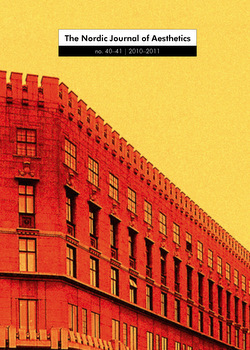Light and the Aesthetics of Perception
DOI:
https://doi.org/10.7146/nja.v22i40-41.5202Abstract
Light seems to be a very changeable size in our build environment. Being an immaterial building stone, light takes a very liquid shape in our design-vocabulary. It consists of an invisible material – photons – and therefore it takes no specific form in itself but is only articulated through the meeting with form. Therefore, since form has been the major theme for the aesthetics up until now, giving form to light is a complex and challenging task and reducing it to Lux and measurable numbers only an escape from facing what is actually perceived. In this way light seems to suffer from what can be called the dichotomy between the aesthetics of the objects and the aesthetics of the perception – as stated by Boehme. To improve practice this article
conducts a study of our perception, focusing more on the effects of light and less on the physical light (lux). By doing so the article tries to give a better understanding of the differences of the regional lighting cultures and the influences creating the differences. The article tries to establish a link between the regional daylight and the use of artificial lighting, showing that daylight, as a background, along with our perception, are determinant factors for how the artificial lighting and the brightness of the room is perceived. The articlehereby suggests that light is not an absolute factor. This means the end of the dichotomy between daylight and artificial light – often expressed by artificial light replacing daylight – instead this article tries to establish a dialogue between the daylight and the artificial lighting. The article describes how light – this intangible building block – can become a more workable size in the aesthetic and architectural practice of today.
Downloads
How to Cite
Issue
Section
License
Authors who publish with this journal agree to the following terms:
- Authors retain copyright and grant the journal right of first publication with the work simultaneously licensed under a Creative Commons Attribution License that allows others to share the work with an acknowledgement of the work's authorship and initial publication in this journal.
- Authors are able to enter into separate, additional contractual arrangements for the non-exclusive distribution of the journal's published version of the work (e.g., post it to an institutional repository or publish it in a book), with an acknowledgement of its initial publication in this journal.
- Authors are permitted and encouraged to post their work online (e.g., in institutional repositories or on their website) prior to and during the submission process, as it can lead to productive exchanges, as well as earlier and greater citation of published work (See The Effect of Open Access).




